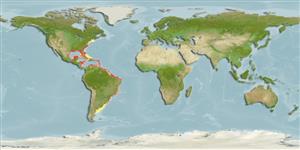Common names from other countries
Environment: milieu / climate zone / depth range / distribution range
Ekologi
Bentopelagis; dH range: 27.5 - 35; kisaran kedalaman 0 - 68 m (Ref. 97531). Tropical
Western Atlantic: USA to Argentina.
Length at first maturity / Size / Weight / umur
Maturity: Lm ? range ? - ? cm Max length : 14.1 cm CW jantan/; (Ref. 367)
Carapace more than twice as broad as long; 9 teeth on broadly arched anterolateral margin (outer orbital tooth and strong lateral spine included); front not so advanced as outer orbital teeth, bearing, between the inner orbital angles, one pair of bicuspid teeth (resulting from the coalition of 2 separate pairs). Convex dorsal surface finely granulate, fissures on orbital margin broadly open; lower surface of carapace hairy; pincers moderate-sized; legs rather short and broad, densely fringed with hairs; fifth legs flattened in form of paddles. Basal segment of abdomen produced on each side into a strong, sharp, slightly upcurved spine. Color: dorsal surface, including pincers, light reddish brown to olive brown covered with many small, rounded white spots, tips of walking legs yellow; color pattern persisting in alcohol.
Minimum carapace width: 2.28 cm (Ref. 93549). Inhabits shallow water along ocean sand beaches and is well adapted to life in the waves and shifting sand; usually in bottom burrows at daytime and emerges at night, at temperatures of 27.5 to 28.6°C and salinities of 27.5 to 35 ppt. Presumably feeds on a variety of items including mollusks, other bottom invertebrates, and some fishes, carrion and detritus (Ref. 367).
Life cycle and mating behavior
Kematangan | Reproduksi, perkembang biakan | Pemijahan | telur-telur | Fecundity | Larva
Ovigerous females have been reported from May to September.
rujukan utama
Acuan | Koordinator | mitra
Tavares, M. 2003. (Ref. 367)
Status IUCN Red List (Ref. 130435)
status CITES (Ref. 108899)
Not Evaluated
Not Evaluated
penggunaan manusia
Perikanan: nilai komersial kecil
| FishSource |
Alat, peralatan
Sumber internet
Estimates based on models
Preferred temperature
(Ref.
115969): 22.5 - 28, mean 25.6 (based on 452 cells).
kategori harga
Unknown.
